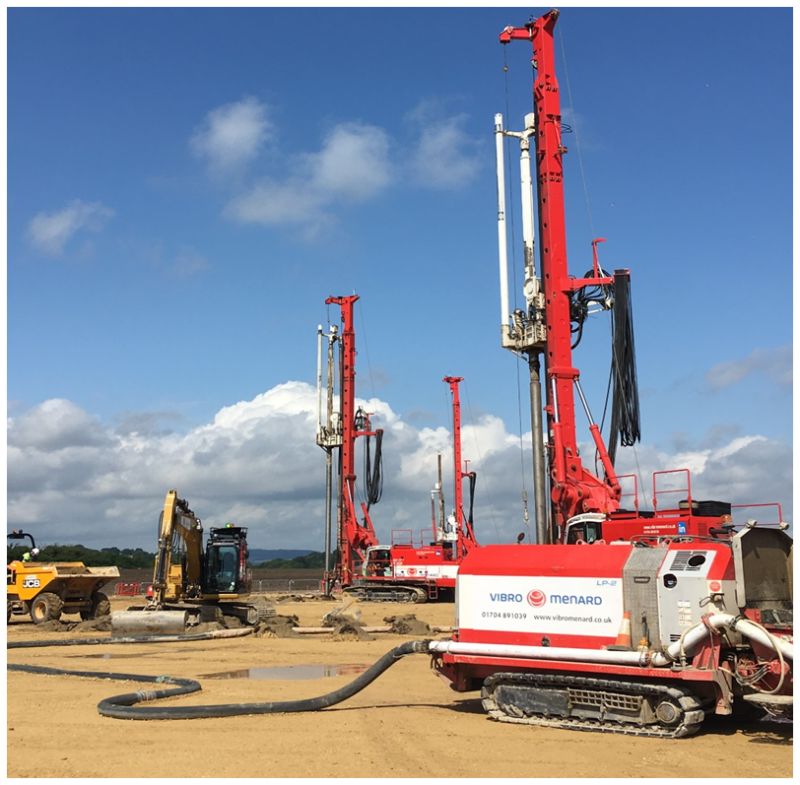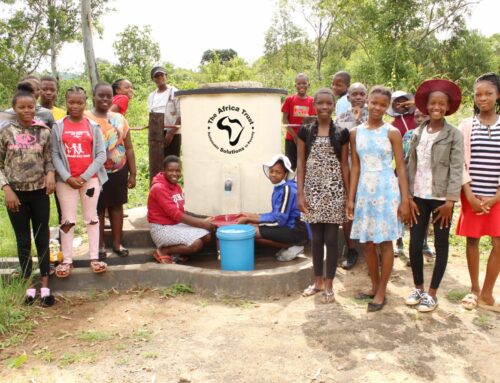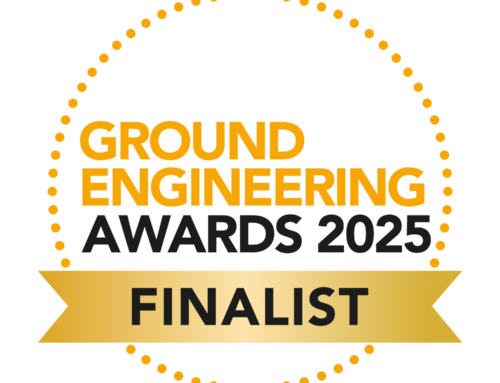GEODRILLING INTERNATIONAL:
Ground treatment as an alternative to piling

Featured recently in GeoDrilling International, Marc Evans, Business Unit Manager, Menard, discusses the options for ground treatments as an alternative to traditional piling techniques and the significant cost and carbon saving benefits in comparison to conventional piling techniques. alongside Derek Taylor, Business Development Director, Keller UK.
…..
Piling is used to transfer building loads through ground which cannot support them to firmer strata below the surface or to construct retaining walls and cofferdams. Pile lengths depend on the ground conditions and can be relatively short or many tens of metres deep. There are many different types of piling methods depending on the purpose, required performance, design and installation process, however, there are also non-piled, methods of ground improvement or treatment that are available, provided by members of the UK’s Federation of Piling Specialists (FPS).
Ground improvement
There are a wide variety of alternative ground improvement solutions, which can provide significant benefits to clients, and although often perceived as higher risk solutions compared to many traditional ‘piling’ methods of foundation support, the risks can be easily managed. The perceived risk generally comes from the misconception that piles will stop a building from settling, whereas ground improvement permits some movement. Undertaken correctly, these techniques can provide cost, programme, and environmental benefits.
The solutions offered by FPS members are highly varied, ranging from the improvement of the existing soils (densification and consolidation) to reinforcement using vertical rigid elements.
In the most simplistic situation, the existing soils are improved to provide enhanced bearing capacities and settlement characteristics, either through the densification of granular soils by the adoption of dynamic techniques such as dynamic compaction or ‘vibro’ compaction or through accelerated consolidation of fine-grained soils using vertical drains and surcharging. Both types of solution are ideal for large areas, particularly beneath embankments and hardstandings.
Where road or rail embankments are required to be built over low-strength fine-grained soils, in the short-term vertical drains can provide a pathway to allow the release of pore water increases, thus allowing embankments to be built quicker without the risk of bearing failure, as well as accelerating any consolidation settlement. With the dynamic compaction solutions, granular made ground up to 8m depth can be improved quickly and effectively, without the need to disturb the existing soils which may be contaminated or by obstructions which may preclude other techniques. Where deeper compaction of sandy/gravelly soils occur specialist vibrators can be used to achieve densification to depths of over 50m plus.
Vertical rigid elements
Where ground improvement by consolidation or densification is not possible, due to technical requirements, build programme or the ground conditions, soils can be reinforced by using vertical rigid elements. These vertical rigid elements are often aggregate columns/piers (where recycled material won on site could possibly be used) or low or ultra-low cement concrete/grouts columns. These vertical elements provide improved bearing capacities and improved settlement characteristics, by limiting the load being imposed on the existing soils and taking up the surplus capacity through the vertical rigid elements.
Although the end solution will be largely governed by the soils and technical specification, the method of installation is varied and is a key factor in the design process, with consideration being given to site-specific practicalities and the depth of treatment.
Vibratory techniques
The most common techniques used in the UK for the installation of aggregate columns/piers are vibratory techniques, in which a cylindrical tool penetrates the ground with the help of vibration. Using this technique aggregate columns up to 700mm in diameter can be achieved and the plant used to install them are often relatively small allowing for access to smaller and tighter sites.
Where larger diameter aggregate columns/pillars are required, these can be installed using dynamic replacement techniques, with diameters up to 2.0m being achievable in softer soils and are ideally suited to larger sites, where embankments, hardstandings or floor slabs are required.
Where soils that require ground treatment are deep ( < 10m) or are generally too soft for aggregate columns/pillars low to ultra-low cement/grout columns can be used, again installed with a variety of techniques. However, the most favoured method is using a displacement auger to limit the amount of spoil generated. These are often referred to as rigid inclusions and depths of installation are typically up to 30m in the UK, although over 50m is possible with the use of specialist plant.
More recently, techniques such as rigid inclusions have migrated into the UK from France, driven by the growth in computing power that allows the analysis of ground behaviour to be scrutinised when it is reinforced with “concrete inclusions”, and where the settlement of such soils would be reduced. This technique is particularly applicable to sites with deep soft soil in alluvial river channels around the Thames, Severn, Mersey and Humber. Here the big advantage is in the concrete and steel which is not needed as floor slabs will be thinner and pad foundations simple. Again, altogether more sustainable than deep piles and ground beams.
In summary ground improvement solutions, as alternatives to piling, provide enhanced bearing capacities and improved settlement characteristics in weak soils for a variety of sectors. This is not necessary as it is exactly where ground treatment fits in.
Carbon reduction benefits
Other benefits are also achievable. With the use of no additional materials or the reduction in the use of material, particularly steel and cement, there is a significant carbon saving in the below foundation solution. In fact, reducing carbon is actually one of the key drivers behind the resurgence of Vibro techniques, as clients strive towards solutions generating less CO2. It is known that Vibro techniques emit just 20% of the CO2 that piling methods do, and that is without the ground beams and pile caps. Typically used in made ground or low-strength soils for housing up to four storeys this represents an ideal solution. However, on larger sites, the greenest technique of all that can be employed is the use of Dynamic Deep Compaction, where a 10t weight is dropped from 10-12m and the made ground is compacted, importing very little material other than a working platform.
Normally this technique would require a site of at least 10,000m2 but most soil types can be treated and thus if CO2 emissions are to be reduced this is the right technique, as it generates around just 10% of the CO2 that a piled solution would. The soils beneath several hundred houses and numerous industrial units have been dealt with in this way and without issue.
It is clearly advantageous to both large and small clients to understand that if you can treat what is there, rather than remove it from site or transport piles down the motorway to install them, there is a clear win for reduced CO2 emissions, as well as a win for the client’s bottom line.
The carbon benefits are of great importance, given the pressure on the industry to achieve its sustainable goals, but there are also benefits from ground improvement options being quicker and using fewer materials, which will equate to a reduction in fuel being used to deliver the project, and this reduction can also be applied to the fuel required to install the foundations.
Managing risk
The management of the design and installation of improvement ground solutions is fundamental to ensuring that risk is controlled, and the benefits are realised by the client. Design is a critical factor. The design of ground improvement solutions is often perceived to be a “dark art”, however, FPS members use sophisticated analyses to ensure that solutions are suitable. This is backed up by detailed designs undertaken by experienced geotechnical engineers. Designs can vary considerably from the treatment of a few metres of loose sands beneath a house plot to a sophisticated 3D FE model for road/rail embankments, often involving category 2 or 3 checks.
Ensuring solutions are installed on-site to design specifics is a critical factor and quality controls, provided by FPS members, are crucial. On-site monitoring through quality checks, instrumentation, material checks/testing and load testing are fundamental givens by FPS members to provide real-time and ongoing confidence to clients.
Another important aspect is adapting to changes on site, particularly when ground conditions are expected to change. Real-time monitoring of the installation can provide guidance on changes and allow adjustments to be made but often advance additional site investigation, typically CPT testing, will be stipulated, not to confirm design suitability, but to ensure that potential adjustments to the on-site installation are known in advance.
In addition to delivering technically sound designs and quality products, FPS members are committed to meeting stringent safety requirements, and this will form the cornerstone of any ground improvement solution that is provided. These standards are audited regularly by the FPS and minimum guidelines must be adhered too to comply with membership.
Summary
When managed effectively, the use of ground improvement or ground treatment solutions can provide enormous cost and carbon savings to clients, but they require early engagement to maximise the opportunity and minimise risk.
FPS members are experienced in delivering alternative solutions to piled methods and are familiar with addressing complex designs and providing ground improvement solutions are underlined by good practice both in safety and quality.
With the piling sector also seeking to play a bigger role in driving down embodied carbon on projects, some of these methods of ground improvement, could and should play a bigger role in construction in the future and it is likely their use will only increase over the coming years.
There is still much work to be done educating clients, as well as regulatory authorities, to demonstrate that foundations need not be all about steel and concrete. However, maybe the need to reduce carbon emissions will ultimately be the primary driver that non-piled methodologies finally need to make them more widely used.
CREDIT: Article from https://www.geodrillinginternational.com/piling/news/1449369/ground-treatment-as-an-alternative-to-piling




